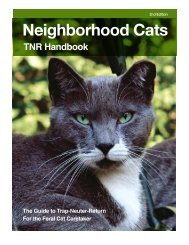Surveying roaming dog populations: guidelines ... - Animal Sheltering
Surveying roaming dog populations: guidelines ... - Animal Sheltering
Surveying roaming dog populations: guidelines ... - Animal Sheltering
Create successful ePaper yourself
Turn your PDF publications into a flip-book with our unique Google optimized e-Paper software.
CONTENTS<br />
INTRODUCTION<br />
COUNTING DOGS<br />
IN PUBLIC AREAS<br />
MONITORING ONCE<br />
INTERVENTION BEGUN<br />
CONCLUSIONS<br />
Monitoring once the intervention has begun<br />
Counting once the intervention has begun<br />
Once an intervention has begun, the number of <strong>roaming</strong> <strong>dog</strong>s can be monitored using the counting methods<br />
described. The section ‘From indicator counts to evaluation’ explains how indicator counts can be used for<br />
monitoring and evaluation once an intervention has begun. Counts suitable for estimating the total<br />
population are likely to take too long to repeat every year. However, they could be repeated after a number<br />
of years to reveal in detail how the population has changed. In the intervening years, a limited count can<br />
be repeated more frequently in selected blocks. The selected blocks would ideally include both those that<br />
are covered by the intervention and those that are yet to be reached by the intervention.<br />
Marking once the intervention has begun<br />
Once intervention has begun there is also the potential to mark a sample of <strong>dog</strong>s and, with limited extra<br />
effort, obtain various types of information, depending on the type of marks applied (temporary or<br />
permanent, and whether they allow individual identification) and the type of intervention (owned <strong>dog</strong>s or<br />
<strong>roaming</strong> <strong>dog</strong>s collected from and returned to the street).<br />
There is extensive literature on the analysis of mark-recapture data and here we have done no more than<br />
offer a few suggestions appropriate to the <strong>roaming</strong> <strong>dog</strong> situation. Clearly it is valuable to know what<br />
percentage of <strong>roaming</strong> <strong>dog</strong>s have been processed by the intervention as it proceeds and to be able to<br />
distinguish <strong>dog</strong>s that have been processed from those that have not, both to compare their welfare status<br />
and to try to see whether there is a difference between the type of <strong>dog</strong>s that are being collected and those<br />
that are not.<br />
Monitoring interventions where owners bring their <strong>dog</strong>s<br />
A number of papers (for example, Matter et al 3 and Kayali et al 4 ) describe a method for estimating<br />
numbers of unowned, owned confined and owned unconfined <strong>dog</strong>s by using collars to temporarily mark<br />
owned <strong>dog</strong>s brought to a temporary clinic for rabies vaccination. Shortly following the intervention a<br />
number of surveys are conducted to count marked and unmarked <strong>dog</strong>s on the street and a household survey<br />
is conducted to determine the fraction of owned <strong>dog</strong>s that are marked and obtain information on the<br />
confinement of marked and unmarked owned <strong>dog</strong>s. The published accounts suggest using Bayesian<br />
statistics to incorporate prior information on confinement and the proportion of <strong>dog</strong>s seen during street<br />
surveys. However, the use of Bayesian statistics is not essential to the technique and two programs can be<br />
downloaded from the “stray<strong>dog</strong>” link at www.conservationresearch.co.uk can be used to estimate the<br />
numbers of owned and unowned <strong>dog</strong>s without the need to assign prior probabilities. The link provides<br />
information on how to run the programs on real data and how to test them on simulated data. The<br />
difference between the “temporary_mark_population” and “temporary_mark_population1” programs is that<br />
the latter relaxes the assumption (used in Matter et al 3 and Kayali et al 4 ) that unconfined owned <strong>dog</strong>s are<br />
as likely to be seen on the street as unowned <strong>dog</strong>s. In a fully urban environment that assumption is<br />
unlikely to hold as owned <strong>dog</strong>s with access to public areas may nevertheless be on private property and<br />
invisible when the street survey is conducted. In the “temporary_mark_population1” method the household<br />
survey is conducted at the same time of day as the street surveys and records the numbers of unconfined<br />
owned <strong>dog</strong>s on the street and within the household at that time.<br />
For owned <strong>dog</strong>s it may be possible to estimate survival using questionnaire surveys, using information on<br />
the fate of <strong>dog</strong>s owned 12 months before the survey, pups born within the last twelve months and, under<br />
certain assumptions, the frequency distribution with respect to age of <strong>dog</strong>s owned currently. Those<br />
methods are available using responses collected over a single questionnaire survey, a follow-up survey or<br />
during the household survey conducted as part of the temporary marking method described above.<br />
Estimates of survival and pup production can be used to drive a model of the <strong>dog</strong> population and hence<br />
compare observed changes in owned and unowned <strong>dog</strong> numbers to the expected changes following the<br />
intervention.<br />
ANNEXES<br />
3 Matter HC, Wandeler AI, Neuenschwander BE, Harischandra LPA, Meslin FX. (2000) Study of the <strong>dog</strong> population and the rabies control<br />
activities in the Mirigama area of Sri Lanka. Acta Tropica 75:95-108<br />
4 Kayali U, Mindekem R, Yémadji, N, Vounatsou P, Kaninga Y, Ndoutamia AG, Zinsstag J. (2003) Coverage of pilot parenteral vaccination<br />
campaign against canine rabies in N’Djaména, Chad. Bulletin of the World Health Organization 81 (10)<br />
14








